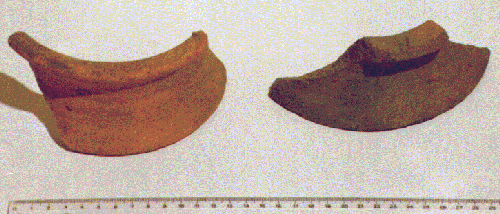|
| Potter’s Trivets from Alcochete near Setúbal: 1st to 3rd centuries AD |

The manufacture of very large vessels of consistent size, weight and quality like the amphorae made near Setúbal required great technical skill on the part of the potters.
Clay extraction and refinement was a long and arduous process, and resulted in pottery fabrics of such standardisation that the geographical source of many Mediterranean amphora fragments found nowadays in Britain, for example, can be identified by examination of the fired clay with a microscope.
Potting the amphorae must have required working with a given weight of clay to a given template, while putting together wheel-made and handmade elements. Firing required absolute control of kiln temperatures and conditions to achieve the standard oxidised colour, as well as the raising and lowering of temperatures over a period of several days and nights to avoid breakage.
The trivets would have been useful for supporting the vessel at various stages of manufacture.
© 1998 Oxfordshire Museum Service, Setúbal Museums and the Benaki Museum